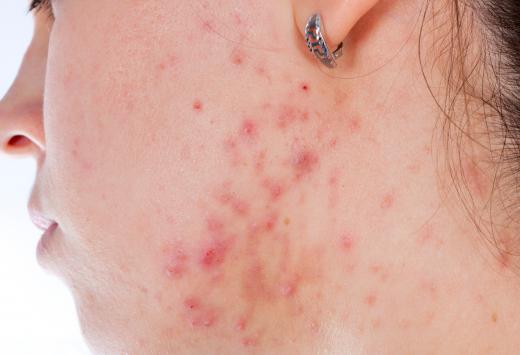At BeautyAnswered, we're committed to delivering accurate, trustworthy information. Our expert-authored content is rigorously fact-checked and sourced from credible authorities. Discover how we uphold the highest standards in providing you with reliable knowledge.
What is a Deep Chemical Peel?
Many different types of facial exfoliation are available for people seeking healthier, younger-looking skin. A deep chemical peel is a type of treatment that involves heavy, acidic chemicals that intentionally cause skin damage, forcing the skin to heal and renew its surface. The treatment is used to remedy damage that already exists, such as scarring and deep wrinkling.
Acetone, phenol, and trichloroacetic acid are some of the chemicals that a deep chemical peel may contain. The ingredients cause a controlled, chemical burning of the top layer of the skin. As the wounds heal, the skin's surface renews itself, resulting in a smoother appearance.

The procedure, known as the strongest form of facial peels, can be performed on the entire face or on isolated, spot areas, such as around the lips. A full professional chemical peel is usually conducted following or preceding another separate operation, such as eyelid surgery or a face lift. The treatment is considered too dangerous to be performed around the eyes.

Fine lines, freckles, liver spots, and other skin discolorations can all be treated with a salicylic acid chemical peel. Sun damage, particularly precancerous spots, may be largely or completely removed through treatment. Old scars can also be treated by being bleached out through the treatment.
People with mild wrinkling or few skin problems are not considered candidates for a deep chemical peel. Minor wrinkles and acne should not be treated through a deep chemical peel; instead, a light chemical peel can be used. To qualify for the procedure, skin must be very damaged. For those who do qualify, deep chemical peels cannot be performed too often, as excessive use of the procedure can cause severe skin damage. Regulation of chemical peel procedures vary by location.

Also known as a phenol peel, this procedure takes half an hour to two hours to complete, depending on the amount of surface being treated. The acidic solution is applied to the selected area. Eyes, lips, and eyebrows should be avoided for proper chemical peel safety. During this application, a burning sensation can occur.
Following the deep chemical peel itself, water is applied to neutralize the acid on the face. After a waiting period, petroleum jelly is coated over the face, ensuring the safety of the healing crust that develops over the burn. The jelly, or a mask of adhesive tape, will remain in place for up to two days. Medication is usually prescribed for any pain that results from the treatment.

New, pink skin begins to form within days. The pinkness, which resembles a sunburn, disappears later. Puffiness, sensitive skin, and a sensitivity to light are common. Patients should remain out of the sun following the application, as well as use sunblock regularly once completely healed. Patients can usually resume work and normal activities within two weeks.
Chemical peel effects can be very dangerous. People with heart conditions should avoid this beauty procedure, as the agents within the peel can cause heart arrhythmias. For patients with herpes, herpes outbreaks can be triggered by this peel, resulting in permanent scarring. The cost of a deep chemical peel is also considered much more expensive than a typical facial peel.
AS FEATURED ON:
AS FEATURED ON:














Discussion Comments
Chemical peels are certainly not for the faint of heart. One tends to look worse right after the procedure than before. And it takes at least two weeks for the healing to be completed.
I had swelling, redness and throbbing pain for about ten days after my deep chemical peel. It was a rough ten days. But I do think that it was worth it because it made a huge difference. I had many deep wrinkles, discoloration and sun spots. I looked much older than my age.
So I do recommend this peel with those experiencing the same issues. Just be prepared for the issues post-procedure and make sure you have someone with you to help you as you heal.
@bear78-- As far as I know, the biggest risk with deep chemical peels isn't scarring, but rather toxicity. Since the chemicals in this type of peel penetrate into the deep layers of skin, a lot of the chemicals are absorbed into the bloodstream. Aside from causing heart arrhythmia, it can also cause issues with the liver.
I'm not a proponent of deep chemical peels for this reason. I think it's better to get a light peel periodically rather than getting a medium or deep peel.
I've read some horror stories about chemical peels and a "deep" chemical peel sounds even scarier. I think some people don't react as well to these peels. Instead of the peel removing scars, it causes scars in some people. Others experience a lot of pain or infection after the procedure.
I might consider a light chemical peel for my acne blemishes, but I don't think I would ever get a deep chemical peel. It's just too risky and there is no way to make sure what the results will be.
Post your comments